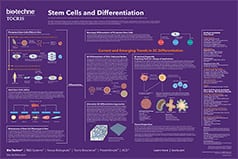Wnt Signaling
Wnt proteins are secreted glycoproteins that regulate diverse developmental processes such as differentiation, cell migration and proliferation during embryogenesis and in adult tissues. Dysregulation of Wnt signaling is known to promote tumorigenesis and metastasis.
Related Targets
The Wnt/β-catenin (canonical) pathway is well-characterized. In the absence of a Wnt protein, cytoplasmic β-catenin levels are kept low by the 'destruction complex', which is composed of adenomatous polyposis coli (APC), axin and glycogen synthase kinase 3 (GSK-3). The destruction complex mediates β-catenin phosphorylation, which tags it for ubiquitination and proteasomal degradation. Wnt proteins bind to Frizzled receptors and LRP co-receptors, which causes activation of Dishevelled family proteins. Dishevelled inhibits the destruction complex leading to an accumulation of cytoplasmic β-catenin. β-catenin translocates to the nucleus where it interacts with transcription factors of the TCF/LEF family and promotes gene expression.
There are two further Wnt signaling pathways. Wnt proteins can stimulate release of intracellular calcium and activate calcium-sensitive enzymes such as PKC, CaMKII and calcineurin. In addition, the Wnt/Calcium pathway has been linked to activation of nemo-like kinase, which phosphorylates TCF transcription factors and inhibits Wnt/β-catenin signaling. The planar cell polarity pathway regulates the polarity of epithelial cells within the plane of an epithelium and involves activation of Rho GTPases, JNK and Rho kinases.
Wnt signaling can be modified by an array of other proteins, for example Sclerostin can bind to LRP co-receptors and inhibit this pathway. Furthermore, CK1 has been suggested to phosphorylate the cytoplasmic domain of LRP to regulate signaling and protein phosphatases have a role in determining the disassembly of the destruction complex.
Literature for Wnt Signaling
Tocris offers the following scientific literature for Wnt Signaling to showcase our products. We invite you to request* your copy today!
*Please note that Tocris will only send literature to established scientific business / institute addresses.
Stem Cells Scientific Review
Written by Kirsty E. Clarke, Victoria B. Christie, Andy Whiting and Stefan A. Przyborski, this review provides an overview of the use of small molecules in the control of stem cell growth and differentiation. Key signaling pathways are highlighted, and the regulation of ES cell self-renewal and somatic cell reprogramming is discussed. Compounds available from Tocris are listed.
Stem Cell Workflow Poster
Stem cells have potential as a source of cells and tissues for research and treatment of disease. This poster summarizes some key protocols demonstrating the use of small molecules across the stem cell workflow, from reprogramming, through self-renewal, storage and differentiation to verification. Advantages of using small molecules are also highlighted.
Pathways for Wnt Signaling
Wnt Signaling Pathway
The Wnt pathway is involved in cellular differentiation and proliferation in adult tissues and also during embryogenesis. Disturbances within the pathway may lead to the formation of tumors and promote metastasis.Wnt Gene Data
| Gene | Species | Gene Symbol | Gene Accession No. | Protein Accession No. |
|---|---|---|---|---|
| Wnt1 | Human | WNT1 | NM_005430 | P04628 |
| Mouse | Wnt1 | NM_021279 | P04426 | |
| Rat | Wnt1 | NM_001105714 | XP_235639 | |
| Wnt2 | Human | WNT2 | NM_003391 | P09544 |
| Mouse | Wnt2 | NM_023653 | P21552 | |
| Rat | Wnt2 | XM_575397 | Q2IBD1 | |
| Wnt2B | Human | WNT2B | NM_004185 | Q93097 |
| Mouse | Wnt2b | NM_009520 | O70283 | |
| Rat | Wnt2b | XM_342308 | Q9QXK5 | |
| Wnt3 | Human | WNT3 | NM_030753 | P56703 |
| Mouse | Wnt3 | NM_009521 | P17553 | |
| Rat | Wnt3 | NM_001105715 | XP_221016 | |
| Wnt3A | Human | WNT3A | NM_033131 | P56704 |
| Mouse | Wnt3a | NM_009522 | P27467 | |
| Rat | Wnt3a | NM_001107005 | XP_220546 | |
| Wnt4 | Human | WNT4 | NM_030761 | P56705 |
| Mouse | Wnt4 | NM_009523 | P22724 | |
| Rat | Wnt4 | NM_053402 | Q4G052 | |
| Wnt5A | Human | WNT5A | NM_003392 | P41221 |
| Mouse | Wnt5a | NM_009524 | P22725 | |
| Rat | Wnt5a | NM_022631 | Q14UC9 | |
| Wnt5B | Human | WNT5B | NM_030775 | Q9H1J7 |
| Mouse | Wnt5b | NM_009525 | P22726 | |
| Rat | Wnt5b | NM_001100489 | Q8CFB3 | |
| Wnt6 | Human | WNT6 | NM_006522 | Q9Y6F9 |
| Mouse | Wnt6 | NM_009526 | P22727 | |
| Rat | Wnt6 | NM_001108226 | XP_237295 | |
| Wnt7A | Human | WNT7A | NM_004625 | O00755 |
| Mouse | Wnt7a | NM_009527 | P24383 | |
| Rat | Wnt7a | XM_342723 | Q8CFB1 | |
| Wnt7B | Human | WNT7B | NM_058238 | P56706 |
| Mouse | Wnt7b | NM_009528 | P28047 | |
| Rat | Wnt7b | NM_001009695 | Q5NSW6 | |
| Wnt8A | Human | WNT8A | NM_058244 | Q9H1J5 |
| Mouse | Wnt8a | NM_009290 | Q64527 | |
| Rat | Wnt8a | NM_001106155 | XP_226051 | |
| Wnt8B | Human | WNT8B | NM_003393 | Q93098 |
| Mouse | Wnt8b | NM_011720 | Q9WUD6 | |
| Rat | Wnt8b | NM_001106359 | XP_219959 | |
| Wnt9A | Human | WNT9A | NM_003395 | O14904 |
| Mouse | Wnt9a | NM_139298 | Q8R5M2 | |
| Rat | Wnt9a | NM_001105783 | XP_220556 | |
| Wnt9B | Human | WNT9B | NM_003396 | O14905 |
| Mouse | Wnt9b | NM_011719 | O35468 | |
| Rat | Wnt9b | NM_001107055 | XP_221015 | |
| Wnt10A | Human | WNT10A | NM_025216 | Q9GZT5 |
| Mouse | Wnt10a | NM_009518 | P70701 | |
| Rat | Wnt10a | NM_001108227 | XP_237296 | |
| Wnt10B | Human | WNT10B | NM_003394 | O00744 |
| Mouse | Wnt10b | NM_011718 | P48614 | |
| Rat | Wnt10b | NM_001108111 | XP_235636 | |
| Wnt11 | Human | WNT11 | NM_004626 | O96014 |
| Mouse | Wnt11 | NM_009519 | P48615 | |
| Rat | Wnt11 | XM_238122 | Q91WY1 | |
| Wnt16 | Human | WNT16 | NM_057168 | Q9UBV4 |
| Mouse | Wnt16 | NM_053116 | Q9QYS1 | |
| Rat | Wnt16 | NM_001109223 | XP_575403 |




